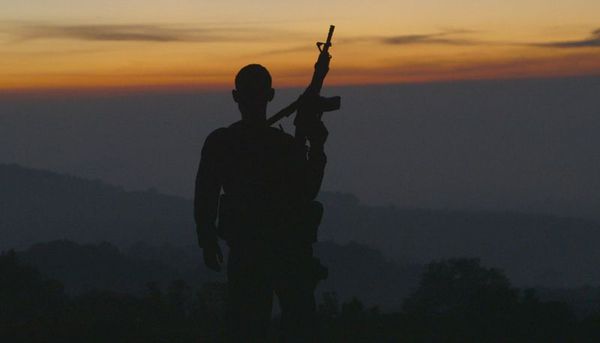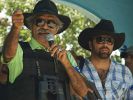Eye For Film >> Movies >> Cartel Land (2015) Film Review
Cartel Land
Reviewed by: Owen Van Spall

Director Matthew Heineman’s Cartel Land, which explores the impact of the Mexican drug war on both sides of the border with the US, is a premier example of how thin the line between documentary and feature film can seem. Certain tense confrontations in this film play out like a modern Michael Mann action flick, while night vision encounters evoke Kathryn Bigelow’s recent thriller Zero Dark Thirty. Heineman takes a twin-track, high-octane approach to create an on-the-ground, embedded study of the journeys of two modern-day vigilante groups as they rally against their shared enemy - the vicious Mexican drug cartels. There isn't much time given to context-setting, there is no voice-over and little on-screen text. This is more a visceral experience than a history lesson, with all the strengths and weaknesses that approach implies. This is an immersive, strikingly shot, incredibly taught meditation on a problem, but one that doesn’t really take a stab at any solutions.
The visual motif that Heineman returns to again and again is the fence between Mexico and the US, that all-too-porous border that is supposed to serve as a block, but in Heineman’s film appears more as a mirror where the two vigilante forces that he is embodied with can - unknowingly - view each other reflected. We see the fence and that strange, barren, unforgiving landscape that it bisects from both ground and aerial level frequently. It is an ominous sight and serves the film’s overall tone and narrative drive well: in the absence of a strong government lead, forces on both sides of this divide will start taking the law into their own hands, in eerily similar ways and at a similar pace. The film charts these devastating and unintended consequences.

Two key figures dominate in Heineman’s narrative, which covers the activities over the past two years. In the Mexican state of Michoacán, Dr Jose Mireles is a charismatic small-town physician who has morphed into the vigilante leader known as "El Doctor,” a figurehead no longer willing to tolerate the cartel running wild in his town and across the wider state. The group he leads have dubbed themselves the “Autodefensas”, an armed citizen uprising against the violent Knights Templar drug cartel that has wreaked havoc in the region for years, taking advantage of a government that the Autodefensas see as either absent or corrupt.
Heineman tracks Mireles as he and his forces take back town after town, his camera team right in the midst of some incredibly taught gun battles, house raids, and - more troublingly - torture sessions where suspected cartel members are brutally interrogated. This is as embedded as you can get; Heineman and his filmmaking team must have been in quite some danger. One of the many tense stand-offs that Heineman is in the midst of with his camera kicks off when local army forces try to disarm Mireles and his unit, leading to outraged townspeople swarming the two groups. Tightly edited to create a clear flow of events, and given that urgency of hand-held camerawork, you could mistake this section of the documentary for an action movie.
Mireles emerges as a flawed hero with undoubted star power and intelligence, but also as a man willing to cross certain ethical lines, such as when he is heard ordering the execution of prisoners, and he is revealed as a leader unable to predict the true consequences of what his movement has started. Heineman appears to have been present for some incredibly candid moments - such as Mireles’ womanising - that do not paint the Autodefensas chief as quite the saintly glow you assume he would desire. In fact, by the end of the film, Mireles has transformed in our eyes from a heroic leader offering a possible citizen - led alternative to government inaction, to a man who has presided over an organisation itself corrupted by the cartels and its own willingness to act just as shadily (for example, Heineman’s camera team are present on one house raid where the Autodefenses basically announce they are going to rob the place).
Across the divide, in the narrow, 52-mile-long desert corridor known as “Cocaine Alley”, Tim "Nailer" Foley heads a small paramilitary group called Arizona Border Recon. Their self-assigned goal is to stop Mexico's drug wars from seeping across the border as, in an eerie parallel to Mireles and his Autodefensas, they feel the US government has abandoned them and any concept of border security. Foley is not as immediately charismatic as Mireles, and it is easy to write him off as one of those “the government is coming for our guns” militia hardcore types. He and his posse affect the uber-macho pose, combat fatigues and slang of professional soldiers, they chew gum, smoke constantly, and carry an absurdly powerful array of high end weaponry.
On the surface, these fringe militia types seem laughable; people who would go looking for a fight even if the cartels went away and more a danger to themselves that any cartel gang. Certainly Foley seems to be recruiting from that disaffected, paranoid slice of American society that views the government as the ultimate enemy. Yet Foley cannot be dismissed so easily. His fear of the cartel’s brutality is certainly given credence by the murderous acts Heineman documents just a few hundred miles and one fence away: acts that include mass killings of men woman and children, beheadings, kidnappings, and the selling of drugs to the poor. Foley himself seems able to give a calm, coherent argument as to why he is doing this, one which is framed in terms of fear of the cartels more than any desire to expel any personal demons: though Heineman doesn’t interrogate him or anyone else on screen as to their deeper motives.
Foley and his crew don’t get as much screentime as Mireles and Michoacán and nor do they display any development in their goals, tactics and knowledge, and it is tempting to think the film would be stronger if it just jettisoned the sections dealing with the American side of the border entirely. But it is understandable why Heineman didn't do that: he obviously feels it is important to show how the drug war is having reciprocal effects.
Although it doesn't really function as a deep forensic analysis, Cartel Land is a hugely impactful, very slickly made documentary, one that succeeds brilliantly at creating a nightmare image of a true, new Wild West. Its out there, right now.
Reviewed on: 08 Jun 2015


















